
Station Name: TWIZELL[Source: Nick Catford]
Twizell Station Gallery 1: 1930s - Winter 1963/64 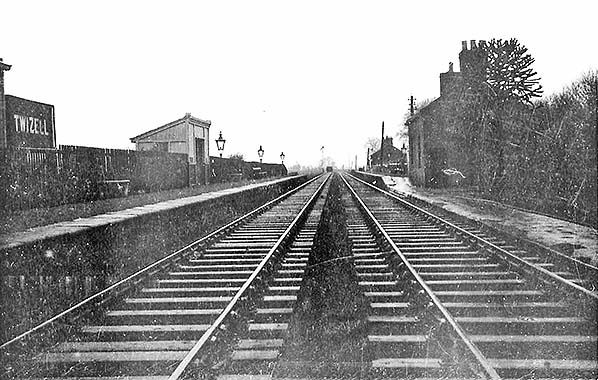 Twizell looking south-west circa 1930s from close to the level crossing. The architecture of this station, a later addition to the NER Kelso Branch, was simpler than at its neighbours. The original stationmaster’s house, thought later to have become the booking office, is close to the up platform ramp (right) and the down platform has a modest timber pent-roofed shelter. The platforms are partially staggered, the up platform displaced some 50yd south-west of its opposite number, for reasons unknown. The running-in nameboard appears to have raised lettering, but is not a standard LNER design; the dark background suggests that it is in LNER livery. The NER casement oil lanterns here were of a slightly more elaborate style than found on many of the company’s stations. In the distance is a pair of railway cottages.
Photo from John Mann and Alan Young collections  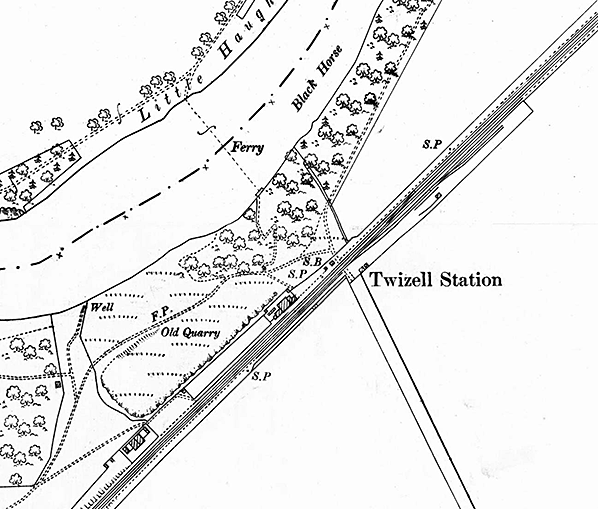
1898 1:2,500 OS map. Although it had opened in 1861, this is the earliest large scale map to show Twizell station. It is in an isolated rural location at the end of a lane from the south-east and close to the River Tweed (immediately north-west of the small area of woodland) which at this point forms the boundary between Northumberland (England) and Berwickshire (Scotland). A ferry is shown connecting a track from Twizell station with the Scottish bank of the river; it is unlikely that this conveyed many passengers from the sparsely populated Berwickshire countryside. The main station building, at this time providing living quarters for the stationmaster, is on the north-west (up) platform with a small waiting shelter on the opposite platform; the platforms are partially staggered, the down one displaced in a north-east direction. A siding is provided for coal traffic and the weigh office (‘W.M.’- weighing machine) is adjacent to the lane. The signal box is north-east of the up platform and two railway cottages are to the south-west of the platform. A much larger house for the stationmaster, would soon be built north-east of the station.
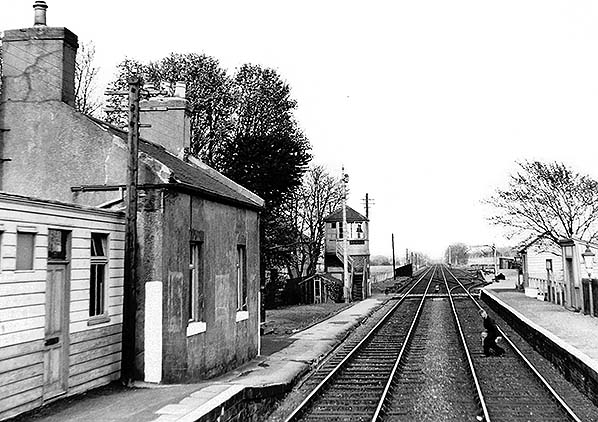
Looking north-east at Twizell station from a departing train on 25 April 1952. The main building of rendered brick was originally the stationmaster’s house and is thought to have become the booking office when a new station house was provided c1900. The timber stggructure in the foreground was originally the ladies’ room. Beyond the up platform ramp a path leads to the level crossing and signal box. On the down platform are two timber buildings, the nearer one being a pent-roofed timber shelter. The running-in nameboard has replaced that seen on the earlier photograph. Beyond the crossing the goods yard is to the right with a small goods dock and a loading gauge.
Photo by J W Armstrong / ARPT 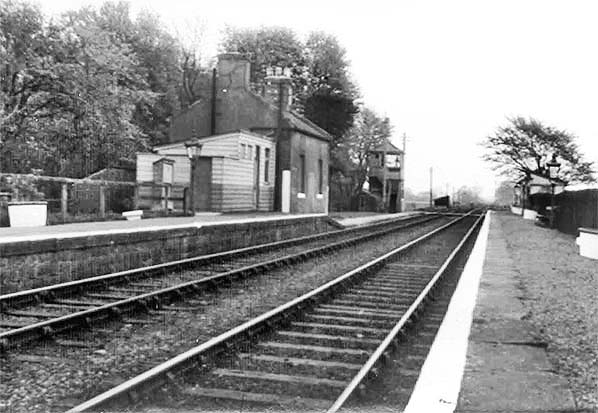 Looking north-east from the down (Kelso-bound) platform at Twizell station in 1952. At this stage the station is still staffed, though its stationmaster is based at Norham; in the following year Twizell would be reduced in status to an ‘unstaffed halt’. The main building and a timber extension are close to the ramp of the up platform; the extension formerly accommodated a urinal at the near end with a ladies’ room beyond. A timber waiting shed can be seen in the distance on the down platform.
Photo from Roy Lambeth collection 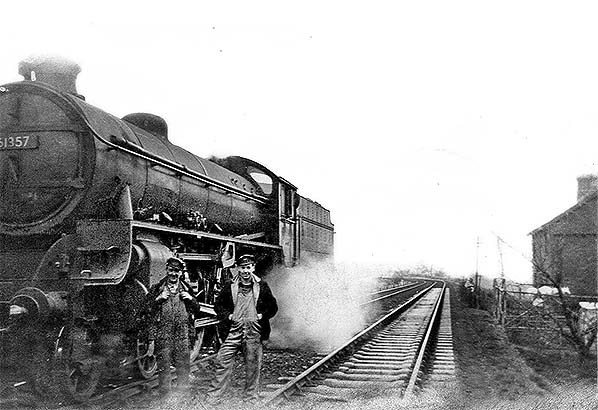
The source of this photograph locates the scene at Twizell and gives the date of 1953. The loco in the picture is Thompson B1 4-6-0 No.61357 which was new ex-works during October 1949. In 1953 she was allocated to St Margarets (Edinburgh) and was withdrawn in 1965. BR introduced LMS style smokebox shedplates on all regions from sometime in 1950; under magnification it appears that No.61357 is not carrying a shedplate, so it is likely to be a little earlier than 1953 (the year provided by the source) perhaps 1951 and unlikely to be later than 1952.
Photo from Colin Ashmore from Railways of Berwick and the Eastern Borders Facebook Group 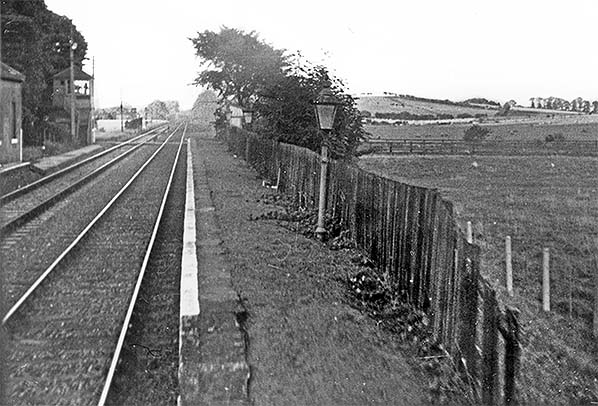
Looking north-east along the down platform at Twizell, probably from a Kelso-bound train. The date is September 1955, so the station had closed to all traffic a few weeks earlier when passenger trains ceased to call. With its clean white lining and lanterns still in place the station could still be in use. To the left the main building and up platform ramp are visible with the signal box close to the level crossing. The goods yard at this station closed in 1953 and the sidings which were beyond the level crossing on the down side have been removed.
Copyright photo by HC Casserley 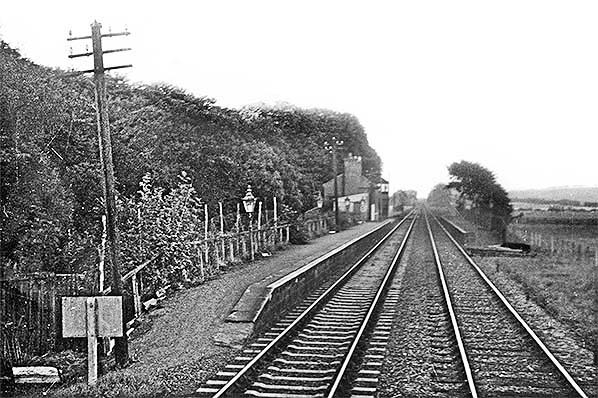
A general view of Twizell station looking north-east in September 1955, several weeks after it had closed to passengers, and to all traffic, having closed to goods in 1953. The partial staggering of the platforms is apparent, the up (left) platform displaced some 50yd south-west of the down. Smart casement lanterns adorn the platforms. The main station building, a plain single-storey structure is seen at the far end of the up platform.
Copyright photo by RM Casserley 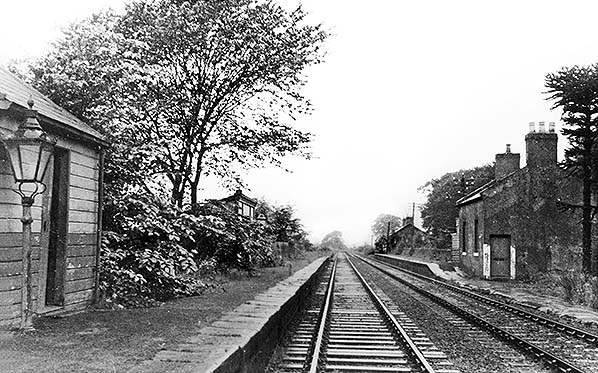 Twizell station looking south-west in August 1958, three years after it had closed to all traffic. The platforms and all of the buildings are intact and the lanterns are still in place, although the station is beginning to show signs of neglect. Beyond the station two railway cottages can be seen on the up side of the line.
Copyright photo from Stations UK 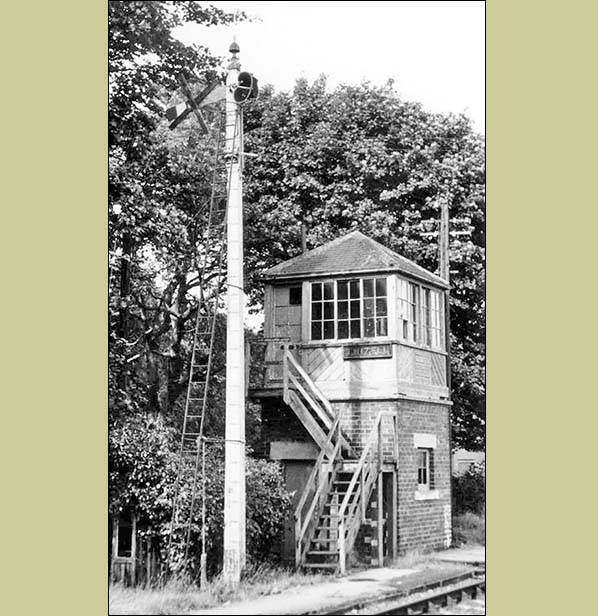
The signal box at Twizell station is seen circa 1958. The box is a 1900 reconstruction of the original structure of 1880. It consists of a non-standard N1 cabin on a later N2 brick base and is equipped with a 20-lever Stevens frame. The box would close on 28 July 1964, a few weeks after passenger trains ceased to operate on the line. The Home signal carries an ‘X’ indicating that it is not in use.
Photo
from Roy Lambeth collection
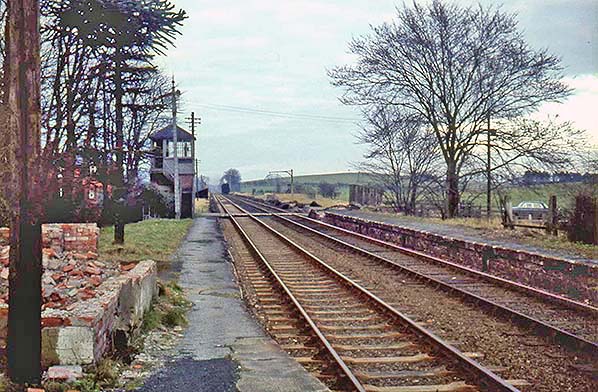
Looking north-west from the disused Twizell station possibly in winter 1963-64 as a local passenger train bound for Kelso and St Boswells approaches in the distance. The station closed to all traffic in 1955. In the foreground are the remains of the station building at the ramp of the up platform, and a tarmac path continues to the signal box and level crossing. The timber buildings on the down platform have been removed. Beyond the level crossing the goods sidings on the right have been lifted but the redundant loading gauge is still in place.
Photo by Morrison Halbert from Roy Lambeth collection / ARPT collection 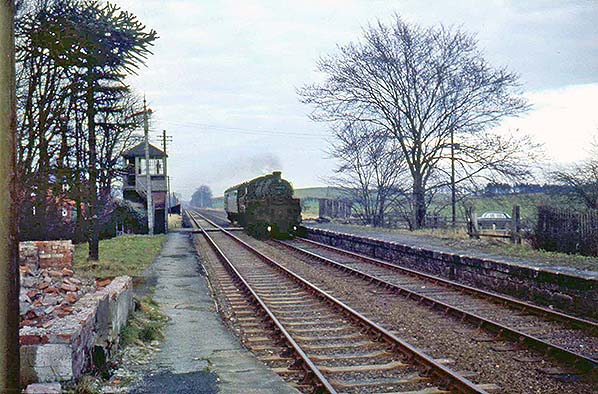 Looking north-west from the disused Twizell station possibly in winter 1963-64 as a local passenger train bound for Kelso and St Boswells approaches. The single BR Mark 1 coach is drawn by a 4MT 2-6-0 loco; its number cannot be seen but it is probably 76049 or 76050, both of which were shedded at Hawick from November 1963. The station’s buildings have been demolished although the signal box at the level crossing is extant. Looking north-west from the disused Twizell station possibly in winter 1963-64 as a local passenger train bound for Kelso and St Boswells approaches. The single BR Mark 1 coach is drawn by a 4MT 2-6-0 loco; its number cannot be seen but it is probably 76049 or 76050, both of which were shedded at Hawick from November 1963. The station’s buildings have been demolished although the signal box at the level crossing is extant.Photo by Morrison Halbert from Roy Lambeth collection / ARPT collection Click here for Twizell Station Gallery 2:
|
 The unusual sounding name is derived from ‘twisla’, an Old English word meaning ‘fork of a river’, referring here to the confluence of the rivers Till and Tweed. This element also appears in the name of Haltwhistle, also in Northumberland. The spelling of the name of the station, the nearby bridge and castle is inconsistent. OS used the spelling ‘Twizell’ until the edition of 1924 from which date it was ‘Twizel’. Bradshaw spelling is Twizell in February 1863, Twizel in August 1887 and December 1895 but Airey’s 1881 and 1893 and RCH Handbook 1904 show Twizell. Reid’s timetable of 1920 confusingly uses the spelling ‘Twizel’. The LNER and British Railways seem always to have used ‘Twizell’.
The unusual sounding name is derived from ‘twisla’, an Old English word meaning ‘fork of a river’, referring here to the confluence of the rivers Till and Tweed. This element also appears in the name of Haltwhistle, also in Northumberland. The spelling of the name of the station, the nearby bridge and castle is inconsistent. OS used the spelling ‘Twizell’ until the edition of 1924 from which date it was ‘Twizel’. Bradshaw spelling is Twizell in February 1863, Twizel in August 1887 and December 1895 but Airey’s 1881 and 1893 and RCH Handbook 1904 show Twizell. Reid’s timetable of 1920 confusingly uses the spelling ‘Twizel’. The LNER and British Railways seem always to have used ‘Twizell’.
 In 1923 the North Eastern Railway was absorbed into the new London & North Eastern Railway at the ‘Grouping’. Shortly before this, in September 1922 James Wood became stationmaster, and he was in post until July 1930. It is likely that at this time Twizell station came under the supervision of either Norham or Coldstream. In August 1947 stationmaster W A Watson was appointed to look after Norham, Twizell and Velvet Hall stations. Twizell station’s passenger traffic was light, but Dean (2011) notes that relative to the population served it was, in fact ,well used with 20 journeys per person per annum, whilst Carham and Sprouston generated only five journeys per head. During the inter-war years road motor transport enticed passengers from many railway stations, but it is not known if any regular bus route ever served Twizell station, situated as it was at the end of a 1½-mile dead-end lane. As noted on the Norham and Velvet Hall pages, these stations were affected adversely by motor bus competition.
In 1923 the North Eastern Railway was absorbed into the new London & North Eastern Railway at the ‘Grouping’. Shortly before this, in September 1922 James Wood became stationmaster, and he was in post until July 1930. It is likely that at this time Twizell station came under the supervision of either Norham or Coldstream. In August 1947 stationmaster W A Watson was appointed to look after Norham, Twizell and Velvet Hall stations. Twizell station’s passenger traffic was light, but Dean (2011) notes that relative to the population served it was, in fact ,well used with 20 journeys per person per annum, whilst Carham and Sprouston generated only five journeys per head. During the inter-war years road motor transport enticed passengers from many railway stations, but it is not known if any regular bus route ever served Twizell station, situated as it was at the end of a 1½-mile dead-end lane. As noted on the Norham and Velvet Hall pages, these stations were affected adversely by motor bus competition. Faced with declining traffic, in 1954 BR proposed to save £7,744 a year by closing Velvet Hall, Twizell, Sunilaws, Sprouston and Carham stations and substantially reducing the number of trains. It was reported that annual revenue from Sunilaws amounted to £217, Velvet Hall £125, and Twizell £66. The numbers of passengers travelling daily in an October census were four, six and two respectively. Bradshaw of February 1955 shows the following timetable, which would be the final one for Twizell, save for retiming from June 1955 of the 10.00am and 3.53pm departures on Saturday only.
Faced with declining traffic, in 1954 BR proposed to save £7,744 a year by closing Velvet Hall, Twizell, Sunilaws, Sprouston and Carham stations and substantially reducing the number of trains. It was reported that annual revenue from Sunilaws amounted to £217, Velvet Hall £125, and Twizell £66. The numbers of passengers travelling daily in an October census were four, six and two respectively. Bradshaw of February 1955 shows the following timetable, which would be the final one for Twizell, save for retiming from June 1955 of the 10.00am and 3.53pm departures on Saturday only. 
 Home Page
Home Page